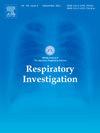Association of poor sleep quality with clinical variables in nontuberculous mycobacterial pulmonary disease
IF 2.4
Q2 RESPIRATORY SYSTEM
引用次数: 0
Abstract
Background
The high prevalence of poor sleep quality in patients with chronic respiratory diseases makes it an important clinical topic. However, the prevalence and characteristics of poor sleep quality in those with nontuberculous mycobacterial pulmonary disease and its association with clinical variables remain unclear.
Methods
This retrospective study involved patients with nontuberculous mycobacterial pulmonary disease between June 2017 and May 2022. The prevalence of poor sleep quality was measured by the Pittsburgh Sleep Quality Index was used to and its association with clinical variables including age, sex, laboratory data, pulmonary function, respiratory symptoms, mental health, health-related quality of life, and physical function was assessed.
Results
The median age of 233 participants was 65 years, with poor sleep quality present in 123 patients (52.8%) who were older, female, and unemployed with dyspnea, anxiety symptoms, low health-related quality of life, and low exercise capacity. Many reported that they "cannot get to sleep within 30 min," "wake up in the middle of the night or early morning," "have to get up to use the bathroom," "cannot breathe comfortably," or "cough or snore loudly." Multivariate logistic regression analysis indicated a significant association between poor sleep quality, female sex, and low health-related quality of life.
Conclusion
Our results suggested that for the patients in this study, a multidisciplinary management that considers poor sleep quality is required and assessment of sleep quality as a screening is needed.
非结核分枝杆菌肺病患者睡眠质量差与临床变量的关系
背景:慢性呼吸系统疾病患者睡眠质量差的高发使其成为一个重要的临床课题。然而,非结核性分枝杆菌肺病患者睡眠质量差的患病率和特征及其与临床变量的关系尚不清楚。方法:这项回顾性研究纳入了2017年6月至2022年5月期间的非结核性分枝杆菌肺病患者。通过匹兹堡睡眠质量指数测量睡眠质量差的患病率,并评估其与临床变量的关系,包括年龄、性别、实验室数据、肺功能、呼吸系统症状、心理健康、健康相关生活质量和身体功能。结果:233名参与者的中位年龄为65岁,其中123名(52.8%)患者存在睡眠质量差的问题,这些患者年龄较大,为女性,无业,伴有呼吸困难,焦虑症状,健康相关生活质量低,运动能力低。许多人报告说,他们“无法在30分钟内入睡”,“在半夜或清晨醒来”,“必须起床上厕所”,“呼吸不舒服”,或者“咳嗽或打鼾很响”。多因素logistic回归分析显示,睡眠质量差、女性性别和低健康相关生活质量之间存在显著关联。结论:我们的研究结果提示,对于本研究的患者,需要考虑睡眠质量差的多学科管理,需要将睡眠质量评估作为筛查。
本文章由计算机程序翻译,如有差异,请以英文原文为准。
求助全文
约1分钟内获得全文
求助全文

 求助内容:
求助内容: 应助结果提醒方式:
应助结果提醒方式:


